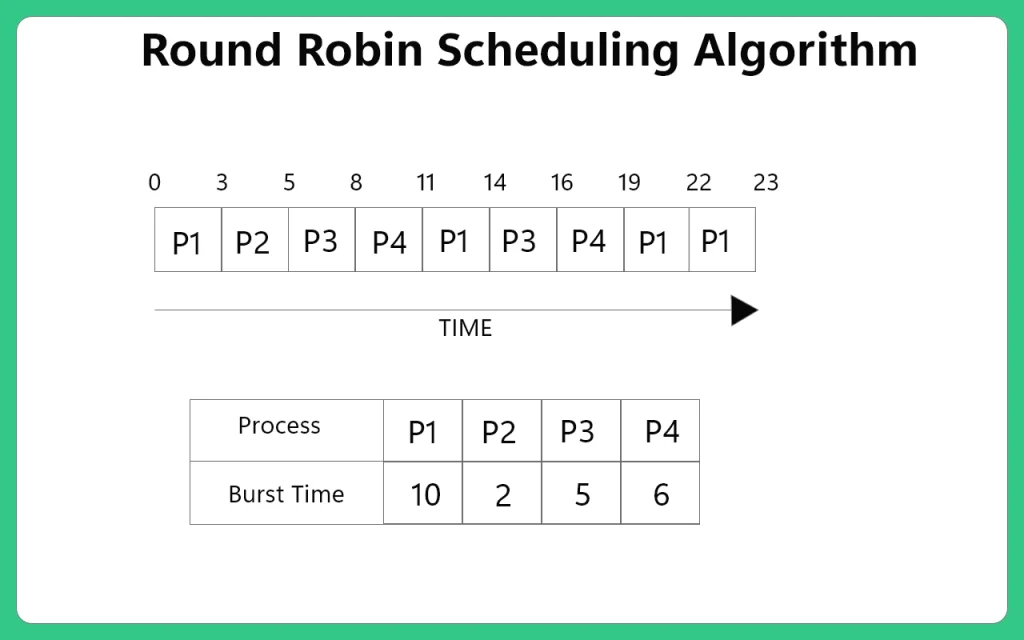Round Robin Scheduling Algorithm in Operating System
Round Robin Scheduling Algorithm in Operating System
Round Robin Scheduling Algorithm in Operating System – When it comes to multitasking in operating systems, scheduling algorithms play a critical role in managing processes efficiently. Among the different types of scheduling algorithms, Round Robin (RR) Scheduling stands out for its simplicity, fairness, and time-sharing capabilities. Whether you’re a computer science student or preparing for technical interviews, understanding the Round Robin scheduling algorithm is essential.
In this blog, we’ll explore the Round Robin Scheduling Algorithm in-depth, including its definition, working mechanism, advantages, disadvantages, practical examples, and comparisons with other algorithms.

Round Robin Scheduling Algorithm in Operating System
In Round robin Scheduling Algorithm, each process is given a fixed time called quantum for execution. After the Quantum of time passes, the current running process is preempted and the next process gets executed for next quantum of time.
- CPU Scheduler goes around the ready queue and allocates CPU to each process for the interval upto 1 time quantum.
- Ready Queue is like a First In First Out Structure, where new processes are at last of the ready queue.
Now, while a process is in that quantum executing, one of the two things will happen
- If the process has a CPU burst of less than quantum time, then as the process gets finished , CPU resources are released voluntarily. the next process in the ready queue occupies the CPU.
- If the CPU burst is larger than the quantum, the timer will go off and the process is preempted, its state is saved by context switching and process is put at last of ready queue. After this, the next process in the ready queue comes in CPU quantum.

Let’s calculate Average Waiting time for each process –
- Average waiting time for P1 = 19- (3+3) = 13ms
- Average Waiting time for P2 = 3ms
- Average Waiting time for P3 = 14-3 = 11ms
- Average Waiting time for P4 = 16-3 = 13ms
Total average waiting time = (13 +3 +11+13)/4 = 10ms
Advantages –
- It does not cause starvation as all process get equal time of CPU.
Disadvantages –
- There is an overhead of context switching as mentioned earlier, too small of quantum time causes overhead and slower execution of process. So, time quantum must be large with respect to Context Switch time.
Prepare for Interview with us:
Time Quantum: The Heart of Round Robin
Time Quantum (also called Time Slice) is the maximum amount of time a process is allowed to run before it is swapped out.
- If the time quantum is too short, frequent context switching occurs, reducing efficiency.
- If the time quantum is too long, Round Robin starts behaving like First Come First Serve (FCFS).
So, choosing the right time quantum is vital for system performance.
Characteristics of Round Robin Algorithm
- Preemptive: Yes
- Fairness: Equal CPU time for each process
- Context Switching: High (depending on time quantum)
- Starvation: Not possible
- Response Time: Better than FCFS and SJF for time-sharing systems
- Ideal For: Time-sharing and real-time operating systems
How to Choose the Best Time Quantum?
Choosing the right time quantum is a balance between performance and fairness.
General Guidelines:
- Too Small: Leads to frequent context switches, increasing overhead.
- Too Large: Behaves like FCFS, reducing interactivity.
- Ideal Time Quantum: Should be slightly higher than the average CPU burst time.
A typical range: 10ms to 100ms depending on system requirements.
Final Thoughts
The Round Robin Scheduling Algorithm is one of the most practical and widely used CPU scheduling techniques in modern-day operating systems. Its fairness, simplicity, and effectiveness in time-sharing environments make it an ideal choice for interactive systems.
However, its performance heavily depends on the chosen time quantum. An optimal setting can ensure smooth system operation, while a poorly selected time slice can lead to inefficiency.
FAQs
The main advantage is fairness. Every process gets an equal chance to execute by receiving a fixed time slice (called a time quantum). This ensures no process is starved and the system stays responsive—especially useful in time-sharing and real-time environments.
- If too short: The CPU spends more time switching between processes (context switching), which reduces efficiency.
- If too long: The algorithm starts to act like First Come First Serve (FCFS), defeating the purpose of fairness and responsiveness.
Yes, Round Robin completely eliminates starvation. Since the CPU cycles through processes in a circular order, every process is guaranteed to get CPU time within a predictable interval.
Round Robin is a preemptive algorithm. Each process gets the CPU for a limited time quantum. If it doesn’t finish within that time, it is forcibly paused and sent to the back of the queue, making space for the next process.



Login/Signup to comment